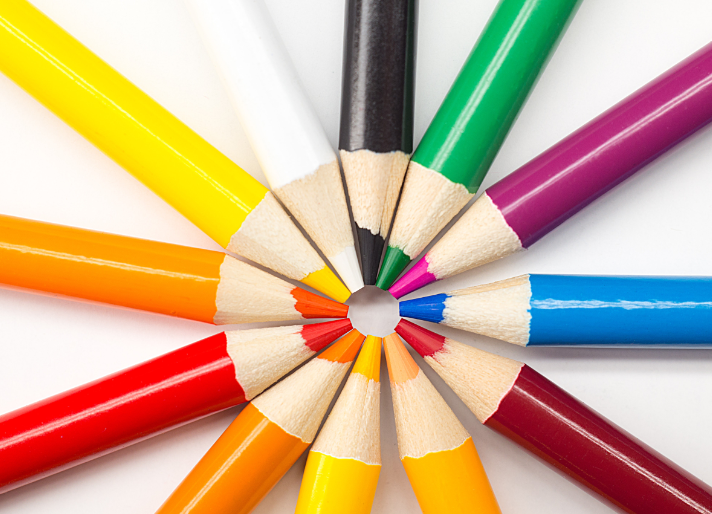Enigmatic foundations underpin the efficacy of design, resting on several pivotal principles. One such principle weaves itself into the fabric of variety. This quintessential concept thrusts its roots deep within a solitary design layout’s heart and branches out to embrace an array of disparate elements. These could span from variations in shape, size, color, texture or any other visual dimension – all conspiring to imbue the design with an ebullient richness that seizes and sustains viewer attention. Thus, these variegated aspects serve as vital anchors in fostering visual intrigue and warding off tedium – staking their claim as indispensable tools in a designer’s arsenal.
Innumerable instances drawn from reality illuminate this enigma called variety at play within design’s realm. Envision it as crafting a melody; mirroring how you’d weave together diverse notes to breathe life into a riveting tune – identical reasoning dovetails into designing too. For instance, let’s wander through a graphic design landscape: here one might interweave starkly contrasting colors, divergent typefaces or even toss together curved lines dancing with angular shapes for company. Such departures from uniformity pepper the terrain with unexpected visual delights that keep curiosity piqued and interest aflame! A judicious sprinkling of such variety intensifies the overall resonance of any design – underscoring not just its significance but also extolling its profound value entrenched within this principle.
The Importance of Variety in Design

In a world where the eyes are constantly under siege from visual stimuli, the role of diversity in design becomes indisputably pivotal in crafting narratives that command and retain viewer attention. The strategic incorporation of a plethora of colors, forms, strokes, and textures can dramatically amplify the visual resonance of a design – rendering it more mesmerizing, engaging and unforgettable. Rather than cluttering up an artistic space with repetitive shapes or hues, designers astutely deploy assorted elements to heighten the aesthetic charm pervading their creations.
Ponder on this instance illustrating the principle of variety in design: Imagine an outdoor marketing billboard for an agency specializing in travel arrangements. It boasts an eclectic mix of images radiating varied colors and typography styles. All these components – ranging from breathtaking landscape pictures to bespoke fonts bathed in vibrant shades – weave together to narrate a visually sumptuous tale capable of igniting wanderlust among prospective tourists. While these ingredients harmonize perfectly with each other to present a cohesive picture- it is their collective diversity which lends intrigue to the visuals while simultaneously fostering focus and interaction.
This creative assortment effectively circumvents any possibility of monotony or dullness seeping into the design thereby making it far from forgettable. Consequently, when employed adeptly – this principle can significantly steer viewers’ perception as well as response thus fortifying its intended message or narrative.
Henceforth we deduce how variety serves not just as mere ornamentation but acts as an essential tool wielded skillfully by designers seeking greater impact through their work.
The Role of Variety in Enhancing Visual Interest
In the realm of design, nestled among foundational tenets like balance, contrast and emphasis, resides the principle known as variety. This principle functions as a potent instrument in the designer’s toolbox, capable of ensnaring both spectator’s gaze and cognition. It is akin to the sprinkling of spices in a culinary creation – heightening each component’s flavor profile. In design terminology, variety refers to infusing an assortment of distinct elements such as shapes or textures; color palettes or typographies.
These principles are not solitary entities but interwoven threads contributing towards a unified aesthetic tapestry. To illustrate this concept with concrete examples from the world of design: picture if you will, a monochromatic website that suddenly springs to life with an unexpected font style addition breaking up uniformity and introducing visual interest point. Or consider an image where elements vary in size and texture leading one through spatial depth illusion.
Such instances portray how variety can intensify viewer engagement levels by sparking curiosity while simultaneously ensuring that designs maintain a visually captivating allure.
Exploring the Different Elements of Variety in Design
In the realm of design, a principle that flutters mysteriously yet meaningfully at its core is that of variety. It whispers about incorporating dissimilarities within the layers of a composition to keep the viewers’ curiosity ignited. This principle empowers designers to voice their uniqueness and singularity while weaving an understandable narrative through their creative labyrinth.
Essentially, it’s a call for diversity in all facets – be it color, texture, shape or size – as an antidote against redundancy and as fuel for visual fascination.
A designer has at his disposal an arsenal full of techniques to seize this principle. A straightforward strategy might be playing around with shapes or tampering with their dimensions – tailoring depth and movement into the design fabric. The role colors play can also not be underestimated; they can serve as actors on stage highlighting key elements in the performance or stirring up audience emotions.
Texture manipulation too proves itself a shrewd tactic; different textures scattered across a canvas like stardust can effectively grasp attention and turn up aesthetic charm. In broader strokes, one could say that this principle acts as both catalyst and muse – driving creativity whilst fostering artistic evolution.
How to Implement Variety in Your Design Work
Imbuing a dash of heterogeneity into your creative blueprints can astonishingly modify the visual interpretation and captivation of your observers. Yet, how does one artfully weave this indispensable aspect into their artistic creations? Uniting theory with application, a significant pathway lies within the pattern principle of design – an overlooked yet remarkably powerful instrument in an artist’s collection.
What constitutes an example of this pattern principle in design? Patterns might encompass recurring elements like shapes, hues, textures or even typography that forge rhythm and uniformity in a composition. Through skillful navigation and manipulation of these patterns – adjusting their scale, orientation or recurrence for instance – a designer can inject diversity; thereby permitting the viewer’s gaze to traverse the blueprint in a subtle but engaging manner. Such deliberate interjection of diversity via pattern design can give rise to enchanting complexities that ward off monotony, enthrall observer curiosity and amplify overall aesthetic allure.
Balancing Unity and Variety in Design
In the intricate universe of graphic design, the deft tightrope walk between unity and variety emerges as a fundamental pillar. Unity signifies that visual togetherness crafting a design into an undivided, consistent entity. It’s the understated adhesive bonding all facets together, guaranteeing there exists a harmonious interlinkage amidst every element.
Conversely, variety embodies the instrument wielded by designers to kindle visual curiosity and dodge tedium—it infuses zest and vigor into designs through embracing diverse forms, hues, textures, dimensions and other divergent elements.
Grasping how to maintain equilibrium between these two pivotal components can significantly amplify your design’s efficacy and allure. An abundance of unity coupled with deficient variety may result in dreariness—causing your audience to detach due to lack of interest. Conversely, if we tilt excessively towards variety while lacking ample unity it could induce chaos or confusion—yielding a disjointed appearance for your design.
The challenge thus lies in walking this thin line—for designers must master blending uniformity with diversity; linking aspects sensibly while also incorporating contrast elements which spark intrigue visually. They need to keep viewers’ eyes engaged yet moving fluidly across their creative canvas.
Practical Techniques for Adding Variety to Designs
Casting the net of variety across your designs can be perceived as a subtle craft, where success is draped significantly in the minutiae. Invoking an array of shapes, sizes, hues and textures could infuse that additional dash of intrigue to any venture. Consider fluctuating the dimensions of elements within your design; manipulating both colossal and minuscule forms or lines for a kinetic and visually tantalizing result. Dabble with color contrasts and gradients to instill depth and aesthetic charm into your creations. Variations in texture too, can articulate volumes by injecting a semblance of realism and palpability into your schematics.
Moreover, introducing novel or unconventional typographies into your designs may induce a profound difference in their overall allure. It’s worth noting that certain fonts are more proficient at encapsulating specific thoughts, emotions or concepts than others are. Henceforth, invest some hours delving into diverse font styles and tampering with font sizes to truly comprehend their influence on your design canvas. In addition to this, don’t shy away from overstepping traditional design grid boundaries which often constrain creativity – embrace asymmetric designs instead – they tend to construct more dynamic compositions filled with interest.
FAQs
Certainly, the term ‘variety in design’ signifies the incorporation of an assortment of elements such as form, hue, texture and motif to infuse excitement and intricacy into a creation. This concept serves to disrupt monotony and captivate observers.
Indeed, diversity is pivotal in designing for it amplifies visual appeal, shatters uniformity and retains observer engagement. It permits creators to strike equilibrium between consistency and complexity; ensuring that their creations do not veer towards being too dull or overly intricate.
Variety acts as an enhancer for visual interest by introducing contrast while creating a sensation of movement. Incorporating diverse elements – ranging from shapes, colors to textures and patterns – prompts viewers’ eyes towards exploration within the design keeping them engrossed.
Components that could instill variety include properties like coloration, form factor, magnitude linearity along with texture depth value definition space allocation etc., Modulating these attributes through techniques such as contrasting hues or shape variation can evoke variedness.
A few pragmatic methods involve using combinations of disparate forms sizes hues textures; cultivating contrast via aspects like luminosity size textural differences; incorporating motifs repetitions thus adding intrigue. Experimenting remains key towards identifying what resonates best with your specific project requirement
The balancing act between consistency & variety entails ensuring elements retain harmony even amidst variations.Achieved via consistent coloring scheme similar styling prevalent throughout repetitive use certain facets.Remember goal should be interesting without inducing viewer confusion visual pandemonium.
Absolutely, excessive diversity could risk the creation becoming bewildering or overwhelming for observers. Striking a balance between diversity and unity remains crucial. While variation does make designs more captivating too much can lead to visual disarray. Similarly overly consistent designs may become dull.The golden rule lies in finding that sweet spot which works best for your unique project.




